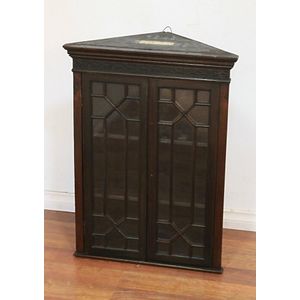Satinwood Breakfront Sideboard by Pratt and Sons
A fine 19th century breakfront sideboard in satinwood and inlays by Pratt and Sons, stamped Pratt and Sons, Guildford, condition: very good, minor veneer and string repairs needed, 107 x 128 x 46 cm
You must be a subscriber, and be logged in to view price and dealer details.
Subscribe Now to view actual auction price for this item
When you subscribe, you have the option of setting the currency in which to display prices to $Au, $US, $NZ or Stg.
This item has been sold, and the description, image and price are for reference purposes only.
- Veneers - Veneers are thin sheets of well-figured timber that are glued under pressure to the surface of a cheaper timber for decorative effect, and then used in the making of carcase furniture.
Early veneers were saw-cut so were relatively thick, (up to 2 mm) but is was realised that saw cutting was wasteful, as timber to the equivilent of the thickness of the saw was lot on each cut.
A more efficient method was devised to slice the timber, either horizontally with a knife, or in a rotary lathe.
Flame veneer, commonly found in mahogany or cedar furniture, is cut from the junction of the branches and main trunk. So-called fiddleback veneers, where the grain is crossed by a series of pronounced darker lines, is usually cut from the outer sections of the tree trunk.
During the 17th and 18th centuries, and in much of the walnut marquetry furniture made during the latter part of the 19th century, the veneer was laid in quarters, each of the same grain, so that one half of the surface was the mirror image of the other.
The use of veneer allows many other decorative effects to be employed, including stringing, feather banding, cross banding, and inlaid decorative panels in the piece. The carcase over which veneer is laid is usually of cheaper timber such as pine, oak or, sometimes in Australia during the first half of the 19th century, red cedar.
The important thing to remember about veneers is that prior to about 1850 they were cut by hand, and were consequently quite thick - ranging up to about 2mm deep.
From the mid-19th century veneers were cut by machines and were almost wafer-thin. This is a critical point when trying to judge the approximate age of veneered furniture. - Breakfront - A design generally found in larger pieces of furniture, such as bookcases, wardrobes and some sideboards. The line of the front is interrupted by the middle section standing out from each end. In a reverse breakfront, the centre section is recessed behind each end. Breakfronted pieces are usually made in three sections the middle and the two wings which are held together by the cornice and pediment, and the plinth on which it stands. The sensible buyer should show caution before buying breakfront pieces, especially bookcases, which are highly desirable and expensive. Always check that the timber, colour, patination, backboards, decoration and thickness of the wood are same in each section.
- Satinwood - Satinwood is a dense pale gold coloured timber that was imported into Britain in the second half of the 18th century, and early 19th centuries from the East Indies and the West Indies. The name derives from the satin-like surface sheen when the timber is polished.
It was used in the solid, as a veneer and in inlays. As well as furniture, satinwood was used for making musical instruments, barometers, boxes and clocks.
It will usually be found on only the very best quality objects, presumably because of of its cost at the time. - Signed or Stamped - A signed piece of furniture may mean that the maker has signed (and hopefully dated) the piece in the same way that we sign a cheque, but more likely, that it bears evidence of the name of the maker, wholesaler or retailer as a paper label, metal plaque, impressed into the timber or in later pieces after about 1880, stamped onto the timber with an ink stamp.
The 'signature' or stamp will always be in an unobtrusive position: under the top of a table, on the underside of the rails of a chair, inside a drawer or on the back.
The fact that a piece is 'signed' considerably enhances its value. Signed Australian furniture is extremely rare, and for imported furniture, it is a mark of quality of the item, as only the items by the top makers or retailers were 'signed'
This item has been included into following indexes:
Visually similar items

Fine antique 19th century four glazed shaped edge panelled front bookcase / vitrine, with gilt bronze mounts, canted sides and quarter veneered panelled sides, 148 cm high, 93 cm wide
Sold by
in
for
You can display prices in $Au, $US, $NZ or Stg.

A Chippendale Revival mahogany two door miniature corner cabinet. 69 cm high, 50 cm long, 26 cm deep
Sold by
in
for
You can display prices in $Au, $US, $NZ or Stg.

Victorian mahogany corner china cabinet on cabriole legs
Sold by
in
for
You can display prices in $Au, $US, $NZ or Stg.

Edwardian mahogany book cabinet two glazed doors on box base
Sold by
in
for
You can display prices in $Au, $US, $NZ or Stg.
